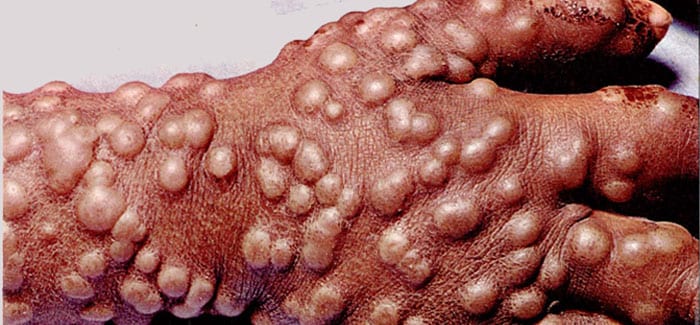Smallpox: Symptoms, Causes, Treatment
What are the symptoms of smallpox?
Smallpox, also known as variola, is a contagious and sometimes fatal disease caused by the variola virus. The symptoms of smallpox typically appear about 12 to 14 days after infection and progress through several stages.
The initial symptoms of smallpox are similar to those of the flu and include:
- High fever
- Fatigue
- Headache
- Backache
- Vomiting
After a few days, a rash develops, which progresses through the following stages:
- Papules: Small, raised bumps appear on the skin, which are firm to the touch and filled with fluid. These bumps are most prominent on the face, hands, and forearms.
- Vesicles: The bumps become larger and filled with pus, and they begin to form a characteristic “pox” appearance.
- Pustules: The vesicles become pus-filled and deeply embedded in the skin. They are very fragile and can easily rupture, releasing infectious fluid.
- Scabs: The pustules dry out and form scabs, which eventually fall off, leaving scars.
During the stages of rash development, the person with smallpox is highly contagious. Smallpox can be a severe and deadly disease, with a mortality rate of about 30% in unvaccinated individuals.
Smallpox was declared eradicated by the World Health Organization in 1980, thanks to a global vaccination campaign. Routine vaccination for smallpox is no longer recommended, as the disease no longer occurs naturally.
What are the causes of smallpox?
Smallpox is caused by the variola virus, which is a member of the Orthopoxvirus genus. There are two forms of the variola virus that cause smallpox: variola major and variola minor. Variola major is the more severe form of the virus, with a higher mortality rate, while variola minor is less severe.
The variola virus is highly contagious and spreads from person to person through respiratory droplets expelled when an infected person coughs or sneezes. It can also spread by direct contact with the fluid from the blisters or scabs of an infected person. The virus can survive for a long time on surfaces and objects, making it highly contagious.
Smallpox is one of the few diseases that only affects humans, and there are no known animal reservoirs for the virus. This fact played a crucial role in the successful eradication of smallpox through a global vaccination campaign.
What is the treatment for smallpox?
There is no specific treatment for smallpox, as the disease is caused by a virus. However, smallpox can be prevented through vaccination, and supportive care can be provided to manage symptoms and complications. Supportive care may include:
- Isolation: Patients with smallpox should be isolated to prevent the spread of the virus to others.
- Hydration: Avoiding dehydration is important, especially if they have a high fever or are experiencing vomiting.
- Fever reduction: Fever-reducing medications, such as acetaminophen (paracetamol), can help reduce fever and relieve discomfort.
- Pain management: Pain relievers, such as acetaminophen or ibuprofen, can help manage body aches and pains.
- Antibiotics: Antibiotics may be prescribed if there is a risk of bacterial infection of the skin lesions caused by smallpox.
- Scarring prevention: Proper wound care can help prevent or minimize scarring from the skin lesions.
- Vaccination: Vaccination can prevent smallpox if given before exposure or within a few days of exposure.
It’s important to note that smallpox has been eradicated, and routine vaccination for smallpox is no longer recommended. However, the variola virus is considered a potential bioterrorism threat, and stockpiles of smallpox vaccine are maintained for emergency use.




